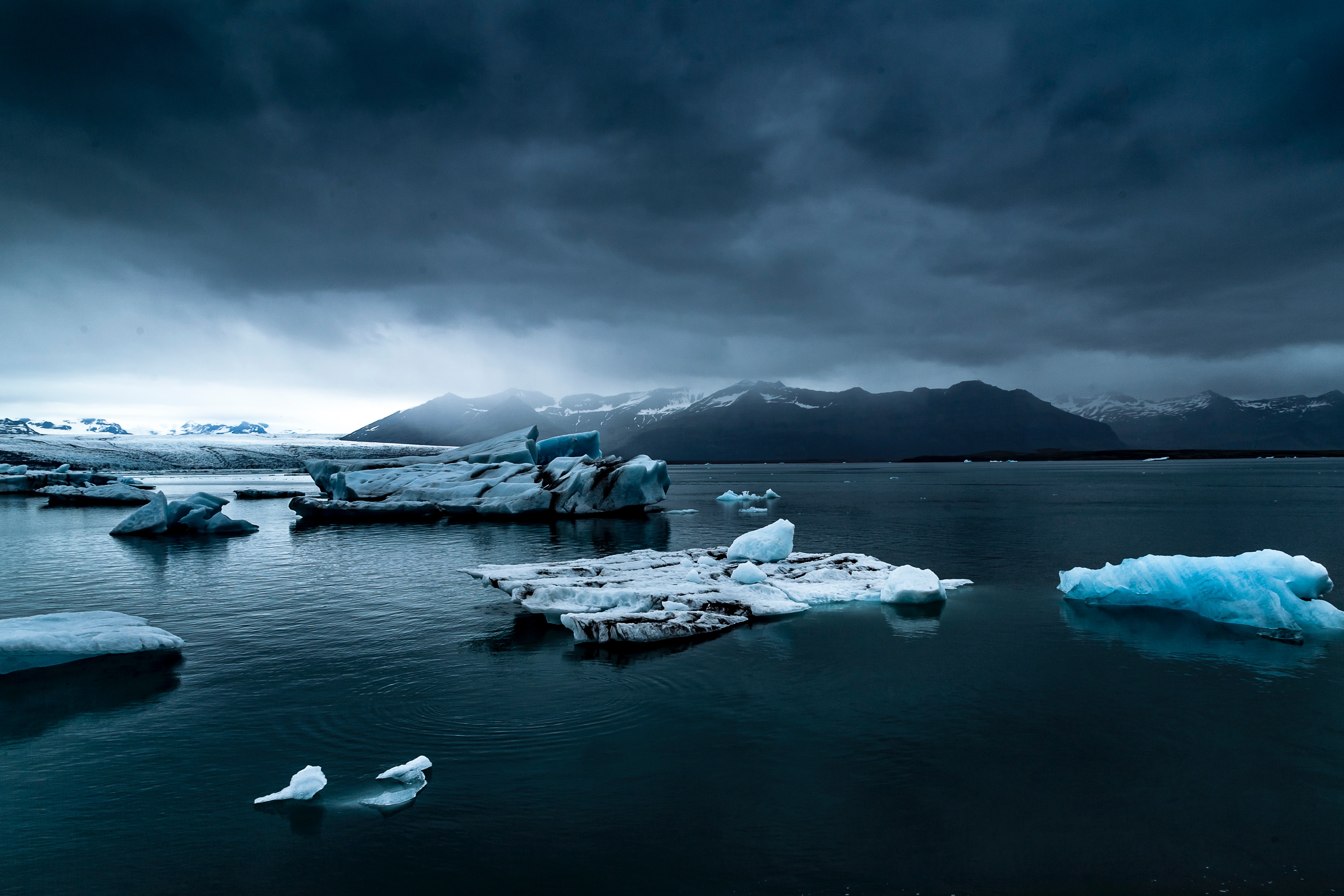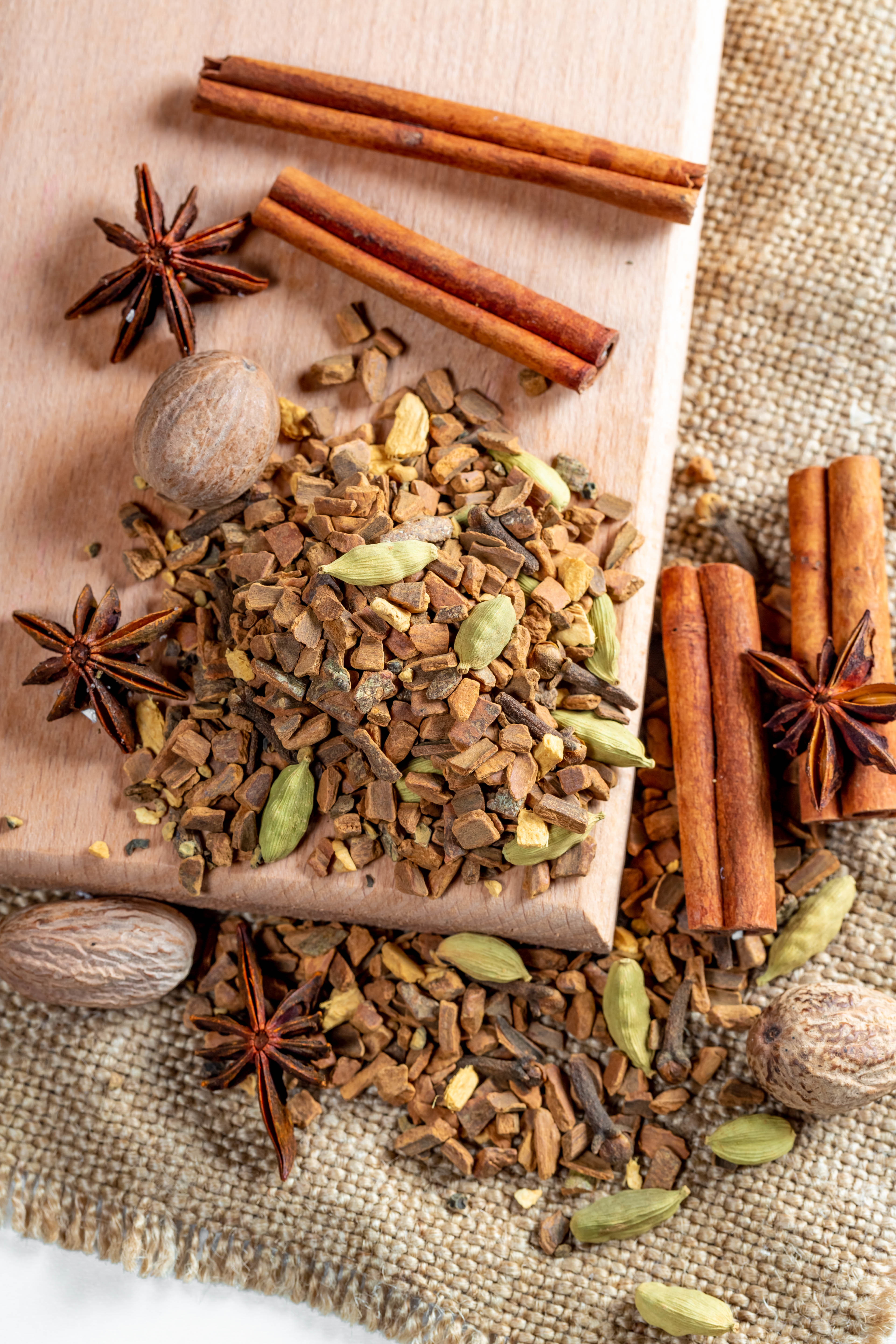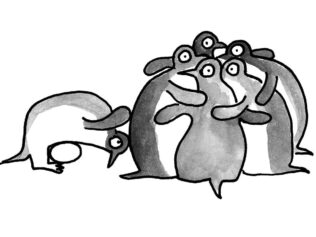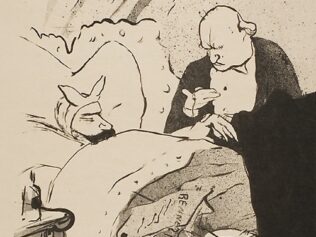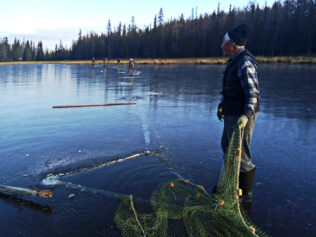
Þingeyri (Thingeyri) is a small town on the fjords of northwest Iceland. Over the centuries, the harsh climate and isolation from the world have forced its residents into behaviour patterns that have guaranteed survival. What remains of them?
Lalla’s hands have touched so many textures. Now they stretch out over a piece of canvas, concentrating. It’s just like in an old book – about the art of bookbinding – lying on the table: vice, brushes, glue, needles, worn wooden tools. One book helps rescue another.
At another table, Alda hits a countertop with a heather-coloured hank. It’s not like the ones I’ve seen in shops. After a while, she starts to slip stitches. Where’s this colour from? It’s wool from the local sheep, boiled in a decoction of blueberries gathered in the valley. The growing season is so short that vegetables for soup don’t really grow here, but it’s easy to find plant dyes outside your house: rhubarb roots, silver Parmelia lichens. And so pots pile up on the table and on the stove, stuffed to the brim. It’s no surprise that one day Alda’s husband almost mistook a colourful decoction for his dinner.
In times when you can buy almost anything and send it anywhere on the planet, in Iceland what you can make yourself or reuse still has tremendous value. It’s not always about savings, though there are some things that even Icelanders find expensive – paradoxically, fish is expensive.
So what’s it about? Social ties, and survival strategies based on reciprocity.
Another idea begins in school. Erna opens the door of the studio. It’s one of the most important spaces in the building. All around are shelves, and on them drawings, sticker art, pictures made with various techniques. Each student has their portfolio. By collecting the works in one place, you can see whether their skills are growing along with them, whether they’re keeping pace with their imaginations. There are also hand-fired dishes, swathes of knitting in neon colours – the effect of experiments in wool dying. One day a week is dedicated to the activities the students choose themselves; that’s the best lesson for creativity. From a Polish parent’s point of view, sometimes it’s hard to understand. When you ask about school, you can hear the reply that this one doesn’t teach anything. The children are always off, celebrating the Day of the Grass or the Day of the Sun.
In a place where nature plays first fiddle and sooner or later everybody has to face up to the experience of solitude, art is important. How important is shown by the percentage of Icelandic artists who’ve made global careers – their calling card is music that opens up space. In Þingeyri alone, one-fifth of the residents (about 50 people) play the accordion. Once a week, they hone their skills at an airport a few kilometres from town that’s not in everyday use. In turn, the local studio of Jón Sigurðsson makes the langspil, a traditional Icelandic instrument (a type of zither). When the stormy weather won’t let up, artistic expression becomes a survival strategy.
Reciprocity first of all
270 residents, a few intersecting streets. A school, a port, a small fish processing plant, a home for people whose children have left for Reykjavík, a cemetery. Another common space is the Simbahöllin café, open in the summer and at Easter – the ideal place to drink a beer and play bingo (completely legal since July 2019; earlier, a law many thought anachronistic prohibited this popular form of recreation during Christian holidays).
The issues that build up over the week can also be aired out in another informal café: at the swimming pool. As the residents say, this is their best coffee house, open year-round. It’s something more than a ritual, because no Icelander can imagine a week without a visit to the pool. It’s not even about swimming. A quarter-hour in the hot pot (a steaming vat) – and a moment in the icy water of a fish container standing outside – is enough. That gets the endorphins pumping.
During the RIFF film festival in Reykjavík, one of the screenings, titled ‘Swim in Cinema’, has traditionally been held at the Sundhöll pool. Suit and towel required! The organizer also ensures warmer water than usual. This is how the audience submerged itself in the dark tale of the Asian horror film The Host.
By a glass wall with a view of the fjord, chairs and loungers stand in neat rows. Between them a table and a picnic set; pitchers, plastic cups. Borbjorg, who takes care of the swimming pool, tops them up every so often. The smell of coffee rises over the water. Neighbours in bathing costumes swap gossip and wave to tourists who keep swimming laps.
“Coffee time! Story time!” – Lalla winks, then goes over to the edge of the water and gives her neighbour a kleinur, a fried pastry. She fried it herself; next time somebody else will make them. Bringing kleinur to the pool is a tradition here. In Þingeyri, the recipe is passed down from generation to generation. You can make a lot, freeze them and then share them with others. Janne managed to convince the community for the recipe to be included in her Simbahöllin Cookbook.
The retirement home is also an open space. You can find Alda here once a week. On sofas and comfortable armchairs, ladies and gentlemen do their needlework: socks for a son, a blanket, a dress for a granddaughter. Those who live in houses everyday spend time with those who can’t afford to be alone anymore. They stitch, consult patterns, help each other out. A shared meal is in the rhythm of the day: cookies, sandwiches, Swiss rolls, coffee. Lalla sits down at the bookbinding table here once a week; concentrating, she fits the scattered pages into a book.
The houses on the fjords – the wooden ones that in another era arrived from Norway on ships – are often set up in a vintage style. Many Icelandic films have such scenes. Objects travel. They don’t make it to the rubbish bin so often. In a region 60 kilometres from the capital there are few shops, and even so, most of them sell second-hand products. “Things are keys that let you open up another person and get to know them,” someone says.
The Museum of Everyday Life, which has operated for several years on the main street of Ísafjörður, uses worn-out objects in its narrations. Into each old book from the municipal library, similar to those Lalla works on, a photo from a resident’s personal album is pasted. The photographs recall the times that were important for them. A year later, such stories are told by worn-out shoes. Art absorbs them, processes them, turns them into signs. The old takes on a new form, or vice versa. Sometimes even literally. On the walls of Simbahöllin, you can see pictures: the tree-woman, a man supported by a cloud – Guðbjörg Lind Jónsdóttir paints slightly surrealistic figures on old baking pans.
Out here you have to have a plan
You can also look at the beautiful, severe views (snow is still on the ground here in May; not all the roads are open in winter) this way: nothing’s happening, stagnation, a lack of prospects; nobody and nothing will help you get out of here.
A dozen years ago there was no café. The green house in the heart of Þingeyri, where Sigmundur Jónsson (Simbi) had sold locally-famous caramel sticks since 1916, looked like a cabinet of horrors. Abandoned by the owner in the 1970s, it has a long history, and years of oblivion. It repelled and attracted. It played the role of a lifetime in Dagur Kári’s 2003 film Nói the Albino (when skipping school, protagonist Nói would hang out in the old bookshop set up in the space).
In 2005, thanks to the Danish-Belgian couple Janne and Wouter, its story got a new start. “Out here you have to have a plan,” they say at our first meeting. Over time, part of the plan became cafés in Simbi’s house, the artists’ residencies in the town, and the public-private partnership Blue Bank – an unused bank building, where before the crisis people would have taken out gigantic loans, changed into an accelerator for international projects. In theory, they were supposed to engage the residents more and integrate the community. A freelancer from the other side of the world could rent a desk here with a view of the fjord.
The artists weave their ideas into this space. It’s easier for somebody from outside to be enchanted, and they can provide an impetus for action; for movement or change. The ones who are from here have to bounce their ideas off somebody, but they’re oriented toward dialogue, the exchange of experiences. As part of the residency in 2020 their ideas include yoga classes, self-reflection and meditation to music.
Sensitivity to others
The population density on the island is 3.2 people per square kilometre. Enough that if you live on a farm, you can just about see your neighbours. In Poland, the figure is 123. That’s still not much if you look, for example, at the capital of Indonesia (which the country plans to move), where every square kilometre holds 15,350 potential neighbours.
Being a neighbour seems to be different in Iceland – it includes mutuality, a non-pushy sensitivity to others’ needs. The traditional approach to many matters (including the issue of language, which has changed only slightly, so Icelanders can still read 13th-century sagas) doesn’t mean closing off to outsiders or to those who arrive from outside the island. Breaking norms in any area isn’t a threat, but a new possibility.
Recently, the Reykjavík authorities once again welcomed LGBT+ refugees from Africa. In the western fjords, in a town near Þingeyri, a group of Syrians settled in 2018 (the programme of supporting and including Syrian families into the life of the local community in the community of Ísafjörður has been going on since 2015).
Are the Icelanders self-sufficient? Of course not, as was shown by events including the 2008 crisis. But they can manage in severe conditions, and it’s not about wowing visitors with geothermal greenhouses where they grow their own bananas. They’re individual and social, unorthodox and open. They give space to themselves and others, because in the land of ice they need each other like they need fire.


